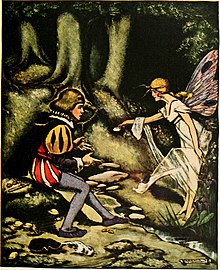| The Love for Three Oranges | |
|---|---|
 The prince releases the fairy woman from the fruit. Illustration by Edward G. McCandlish for Édouard René de Laboulaye's Fairy Book (1920). | |
| Folk tale | |
| Name | The Love for Three Oranges |
| Also known as | The Three Citrons |
| Aarne–Thompson grouping | ATU 408 (The Three Oranges) |
| Region | Italy |
| Published in | Pentamerone, by Giambattista Basile |
| Related | |
"The Love for the Three Oranges" or "The Three Citrons" (Neapolitan: Le Tre Cetre) is an Italian literary fairy tale written by Giambattista Basile in the Pentamerone.[1] It is the concluding tale, and the one the heroine of the frame story uses to reveal that an imposter has taken her place.
The literary tale by Basile is considered to be the oldest attestation of tale type ATU 408, "The Three Oranges", of the international Aarne-Thompson-Uther Index. However, variants are recorded from oral tradition among European Mediterranean countries, in the Middle East and Turkey, as well as across Iran and India.[2]
- ^ Giambattista Basile, Pentamerone, "The Three Citrons" Archived 2014-07-04 at the Wayback Machine
- ^ Kawan, Christine Shojaei. "Orangen: Die drei Orangen (AaTh 408)" [Three Oranges (ATU 408)]. In: Enzyklopädie des Märchens Online. Edited by Rolf Wilhelm Brednich, Heidrun Alzheimer, Hermann Bausinger, Wolfgang Brückner, Daniel Drascek, Helge Gerndt, Ines Köhler-Zülch, Klaus Roth and Hans-Jörg Uther. Berlin, Boston: De Gruyter, 2016 [2002]. p. 348. https://www-degruyter-com.wikipedialibrary.idm.oclc.org/database/EMO/entry/emo.10.063/html. Accessed 2023-05-19.
